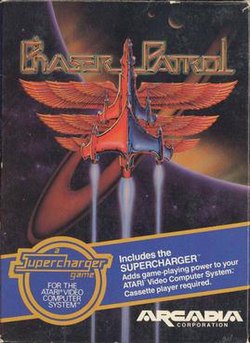| Phaser Patrol | |
|---|---|
 | |
| Developer | Starpath |
| Publisher | Starpath |
| Designer | Dennis Caswell [1] |
| Platform | Atari 2600 |
| Release |
|
| Genre | Space combat simulator |
| Mode | Single-player |
Phaser Patrol, written by Dennis Caswell, [1] is the first numbered release by Arcadia for the Atari 2600 and the pack-in game for the Atari 2600 Supercharger accessory in 1982. The company changed its name to Starpath after launch, and the hardware was rebranded the Starpath Supercharger.
Contents
The game simulates space combat in which the player pilots a ship to destroy Dracon invaders. It is largely a clone of Star Raiders for the Atari 8-bit computers.
